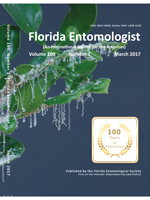Polybia scutellaris (White) (Hymenoptera: Vespidae), a eusocial wasp native to South America, is a generalist predator (Tellería 1996; Fernández Corujo et al. 2010) that feeds on many insect species, including pest species (Barros et al. 2015). Workers forage for food resources (proteins, carbohydrates), material for nest building (plant fiber, clay, water) (Jeanne 1996), water for thermoregulation of the colony (Kovac et al. 2009), and nectar for energy (Beggs 2001; Wegner & Jordan 2005). Social wasps can thrive in diverse habitats, including artificial or highly modified environments, such as agricultural areas (De Souza et al. 2012), and their role as a predator can be exploited as a component in pest management programs (Prezoto et al. 2006). However, these insects may also damage fruit, such as jabuticaba (Plinia cauliflora [Mart.] Kausel; Myrtaceae) (De Souza et al. 2010), guava (Psidium guajava L.; Myrtaceae) (Brugger et al. 2011), and mango (Mangifera indica L.; Anacardiaceae) (Barbosa et al. 2014), during foraging, which renders the fruit unsuitable for sale (Brugger et al. 2011). The wasps also are attracted to food and garbage, and forage in sites such as trade fairs, camp grounds, and picnic areas, and, therefore, frequently come into contact with people and represent a risk (Dvořák & Landolt 2006).
The foraging behavior of P. scutellaris on iamb fruit, Syzygium jambos (L.) Alston (Myrtaceae), was recorded in Feb 2016 for 5 d, hourly from 7 AM to 6 PM, on a S. jambos tree in Santo Antônio do Aventureiro, Minas Gerais, Brazil (21.750060°S, 42.800032°W).
Thirty-two foraging P. scutellaris workers were monitored, of which 26 visited ripe ground fall iamb fruits and 6 visited fruit still on the branches. Twenty wasps fed through preexisting damage and 12 pierced the skin of iamb fruits. Each visit to fruits lasted for 18 ± 7 (7-32) s, and visits occurred most often late in the morning (11 AM) and early afternoon (2 PM) (Fig. 1).
Iamb fruit on the soil used by P. scutellaris had preexisting damage and was fermenting (Dvořák & Landolt 2006; Landolt et al. 2014). Ground fall fruits were visited by this wasp due to recruitment and information on available food resources (D'Adamo & Lozada 2014; Sabrina et al. 2014; Santoro et al. 2015).
Temperature, light, and humidity affect social wasp foraging (Nadeau & Stamp 2003; Monceau et al. 2013), and wasp activity observed in this study was more intense in the warmer periods of the day. Diurnal variation in the intensity of activity may be a response to environmental conditions such that the energy costs and duration of foraging are reduced by optimizing body temperature (Kovac et al. 2015; Agrawal & Karsai 2016). Also, damage to iamb fruit by foraging wasps reduces their commercial value, and actions to reduce damage may be required, such as removing wasp colonies during fruiting.
Fig. 1.
Daytime foraging activity of Polybia scutellaris on Syzygium jambos fruits. No data were collected at 1 PM.

We acknowledge Conselho Nacional de Desenvolvimento Científico e Tecnológico (CNPq), Coordenação de Aperfeiçoamento de Pessoal de Nível Superior (CAPES), and Fundação de Amparo à Pesquisa do Estado de Minas Gerais (FAPEMIG) for financial support.
Summary
We report on the foraging behavior of Polybia scutellaris (White) (Hymenoptera: Vespidae) and the damage it causes to the fruit of Syzygium jambos (L.) Alston (Myrtaceae). Of 32 wasps monitored, 26 visited fruit on the ground and 6 visited fruit on the branches. Foraging was most frequent in late morning and early afternoon.
Key Words: biological control; pre-harvest damage; foraging
Sumário
Polybia scutellaris (Write) (Hymenoptera: Vespidae) preda insetos pragas, porém pode danificar cascas de frutos de Syzygium jambos (L.) Alston (Myrtaceae), tornando-os comercialmente inviáveis. Trinta e dois indivíduos dessa vespa foram observados, 26 visitando frutos amadurecidos no solo e seis naqueles fixos nos galhos. O forrageio de P. scutellaris foi mais frequente no final da manhã e início da tarde.
Palavras Chave: controle biológico; dano pré-colheita; forrageio





